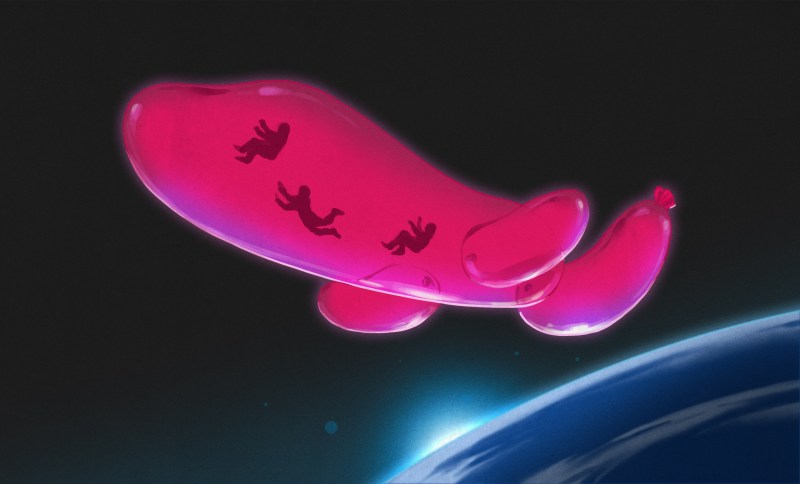
Recently, a prototype inflatable space station module built by Sierra Space exploded violently on a test stand at NASA’s Marshall Space Flight Center in Alabama. Under normal circumstances, this would be a bad thing. But in this case, Sierra was looking forward to blowing up their handiwork. In fact, there was some disappointment when it failed to explode during a previous test run.
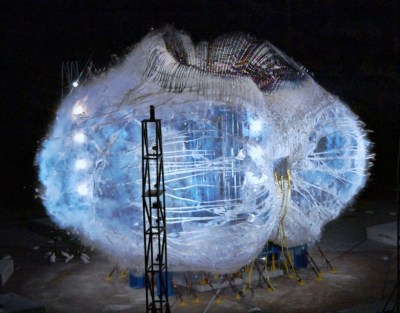
That’s because the team at Sierra was looking to find the ultimate bust pressure of their 8.2 meter (26.9 foot) diameter Large Integrated Flexible Environment (LIFE) module — a real-world demonstration of just how much air could be pumped into the expanding structure before it buckled. NASA recommended they shoot for just under 61 PSI, which would be four times the expected operational pressure for a crewed habitat module.
By the time the full-scale LIFE prototype ripped itself apart, it had an internal pressure of 77 PSI. The results so far seem extremely promising, but Sierra will need to repeat the test at least two more times to be sure their materials and construction techniques can withstand the rigors of spaceflight.
Sierra is a targeting no earlier than 2026 for an in-space test, but even if they nail the date (always a dubious prospect for cutting edge aerospace projects), they’ll still be about 20 years late to the party. Despite how futuristic the idea of inflatable space stations may seem, NASA first started experimenting with the concept of expandable habitat modules back in the 1990s, and there were practical examples being launched into orbit by the early 2000s.
NASA TRANSHAB
As NASA finalized plans for what we now know as the International Space Station, it was understood that most of the components for the orbiting complex would need to fit inside the payload bay of the Space Shuttle. In practice, this meant that Station modules would need to be largely cylindrical in shape, and no longer than approximately 18 m (60 ft). These alone weren’t particularly difficult parameters to work around, as previous space stations from the US and Soviet Union faced similar limitations from their respective launch vehicles. The tricky bit was that the Shuttle’s payload bay was only 4.6 m (15 ft) wide.
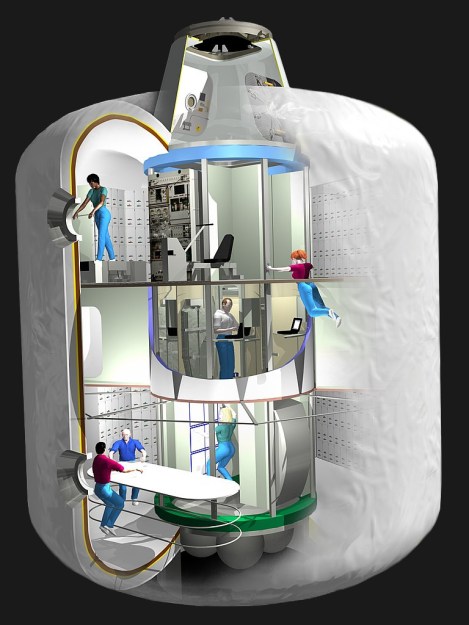 While this allowed for modules slightly wider than what had been used thus far for Mir, it was a considerable downgrade when compared to the 6.6 m (21.6 ft) diameter “Orbital Workshop” module of Skylab. Seeing this as a potential long-term problem, engineers at NASA turned to an idea that had originally been conceived for a theoretical mission to Mars: an inflatable habitat module that could be packed into the Shuttle’s payload bay and then expanded to its final size of 8 m (26 ft) once in orbit and filled with air.
While this allowed for modules slightly wider than what had been used thus far for Mir, it was a considerable downgrade when compared to the 6.6 m (21.6 ft) diameter “Orbital Workshop” module of Skylab. Seeing this as a potential long-term problem, engineers at NASA turned to an idea that had originally been conceived for a theoretical mission to Mars: an inflatable habitat module that could be packed into the Shuttle’s payload bay and then expanded to its final size of 8 m (26 ft) once in orbit and filled with air.
The proposed module, known as TransHab, was to be divided into multiple decks providing living and working areas for the astronauts as well as ample storage. There would have been six individual crew cabins, a dedicated workout area, medical facilities, a fully-equipped kitchen, and a large wardroom table that could be used for all-hands meetings or group meals.
Unfortunately, due to delays and cost overruns on the overall International Space Station program, NASA was ordered to stop R&D on inflatable modules like TransHab in 2000. Construction was instead started on a more simplistic habitation module which could fit inside the Shuttle, but ironically, this too was ultimately canceled.
Even today, there is no official “habitat” module on the ISS — facilities for the sleeping, eating, and exercising are instead spread throughout the Station.
BIGELOW AEROSPACE
While NASA was forbidden by House Resolution 1654 to work on their own inflatable Station modules, the bill did include language that said the space agency could lease such a module if it was built by private industry. Having heard about the cancellation of TransHab, entrepreneur Robert Bigelow contacted the space agency and was able to secure the necessary rights to commercialize the research they had already done on inflatable modules through his company Bigelow Aerospace.
TransHab development had been largely conceptual at this point, and Bigelow Aerospace spent the next several years taking NASA’s ideas and turning them into a practical test article. One of the improvements they made was the addition of Vectran to the inflatable structure. Twice as strong as Kevlar, this manufactured fiber is spun from a liquid-crystal polymer, and had previously been used in the airbag which allowed Pathfinder to safely land on Mars in 1997.
Genesis I
In 2006, Bigelow Aerospace had developed NASA’s original concept to the point that they were ready to launch a functioning prototype.
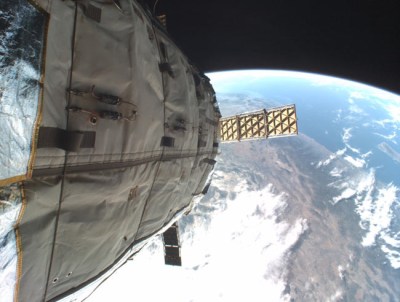 The Genesis I module had a length of 4.40 m (14.4 ft), and expanded from its original diameter of 1.60 m (5 ft 3 in) at launch to 2.54 m (8 ft 4 in) in an operation that took roughly 10 seconds to complete. Its solar arrays provided power for onboard diagnostic systems and more than a dozen cameras which recorded the inflation from both inside and outside of the module.
The Genesis I module had a length of 4.40 m (14.4 ft), and expanded from its original diameter of 1.60 m (5 ft 3 in) at launch to 2.54 m (8 ft 4 in) in an operation that took roughly 10 seconds to complete. Its solar arrays provided power for onboard diagnostic systems and more than a dozen cameras which recorded the inflation from both inside and outside of the module.
Designed to operate for six months, the Genesis I module transmitted data back to Bigelow Aerospace for two and a half years before finally going dark. While the onboard systems stopped transmitting useful data, the structure itself remained completely intact with no signs of pressure loss or other degradation.
Currently, Genesis I remains in a stable 463 x 471 km (287 x 292 mile) orbit at an inclination of 64.5°, and is cataloged as NORAD 9252 and COSPAR 2006-029A.
Genesis II
Following on the success of their first prototype module, Bigelow Aerospace launched Genesis II a year later in 2007. This second module was largely identical from a external and mechanical standpoint, but added even more cameras, reaction wheels which allowed the module to better orient itself in space, an improved gas inflation system, and an upgraded sensor suite.
Like its predecessor, Genesis II transmitted data for more than two years, and remains in a very similar 452 x 505 km (280 x 314 mile) orbit. It’s cataloged as NORAD 31789 and COSPAR 2007-028A.
Bigelow Expandable Activity Module (BEAM)
After nearly a decade of further development, Bigelow Aerospace finally provided NASA with an inflatable ISS module in 2016. The space agency paid $17.8 million for the module, and it was delivered to the Station inside the unpressurized trunk of a SpaceX Dragon. From there, the Canadarm2 robotic arm was used to attach BEAM to the aft port of the Tranquility module.
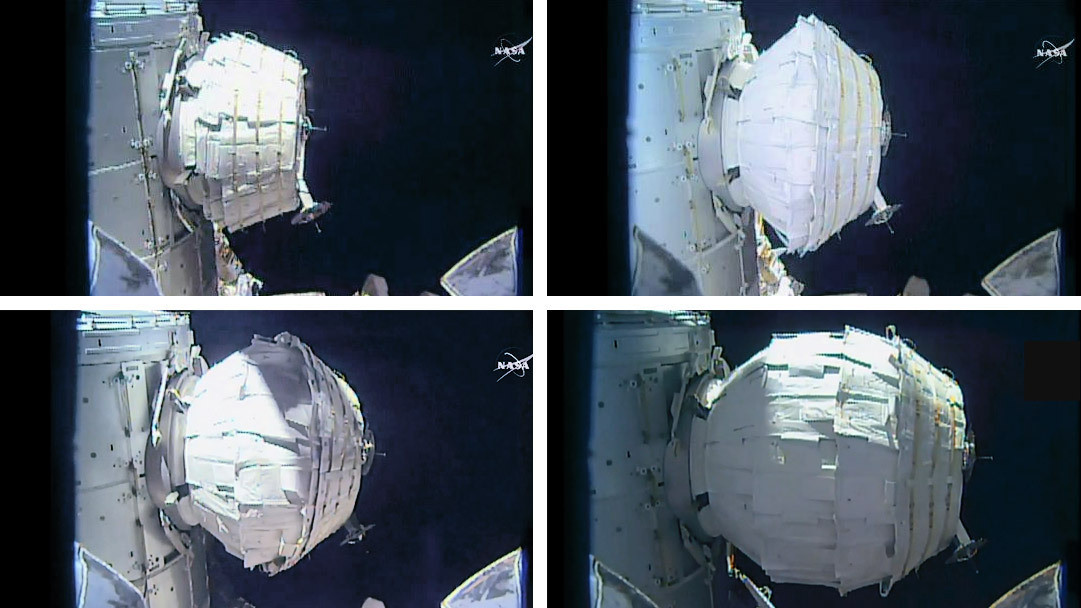
Unlike the twin Genesis modules, BEAM could expand both its length and diameter. When packed into the Dragon’s trunk, it was 2.16 m (7 ft 1 in) long and 2.36 m (7 ft 9 in) in diameter. After an expansion process which took seven hours, it measured 4.01 m (13.2 ft) long with a diameter of 3.23 m (10.6 ft).
A fully developed inflatable module would have included internal fixtures and equipment, but being a test article, the inside of BEAM was essentially just open space. After monitoring the module for a year, it was decided to use it for storage, and the inside of BEAM was outfitted with cloth bags. Following an engineering assessment in 2019, NASA decided that the module would remain attached to the ISS until at least 2028.
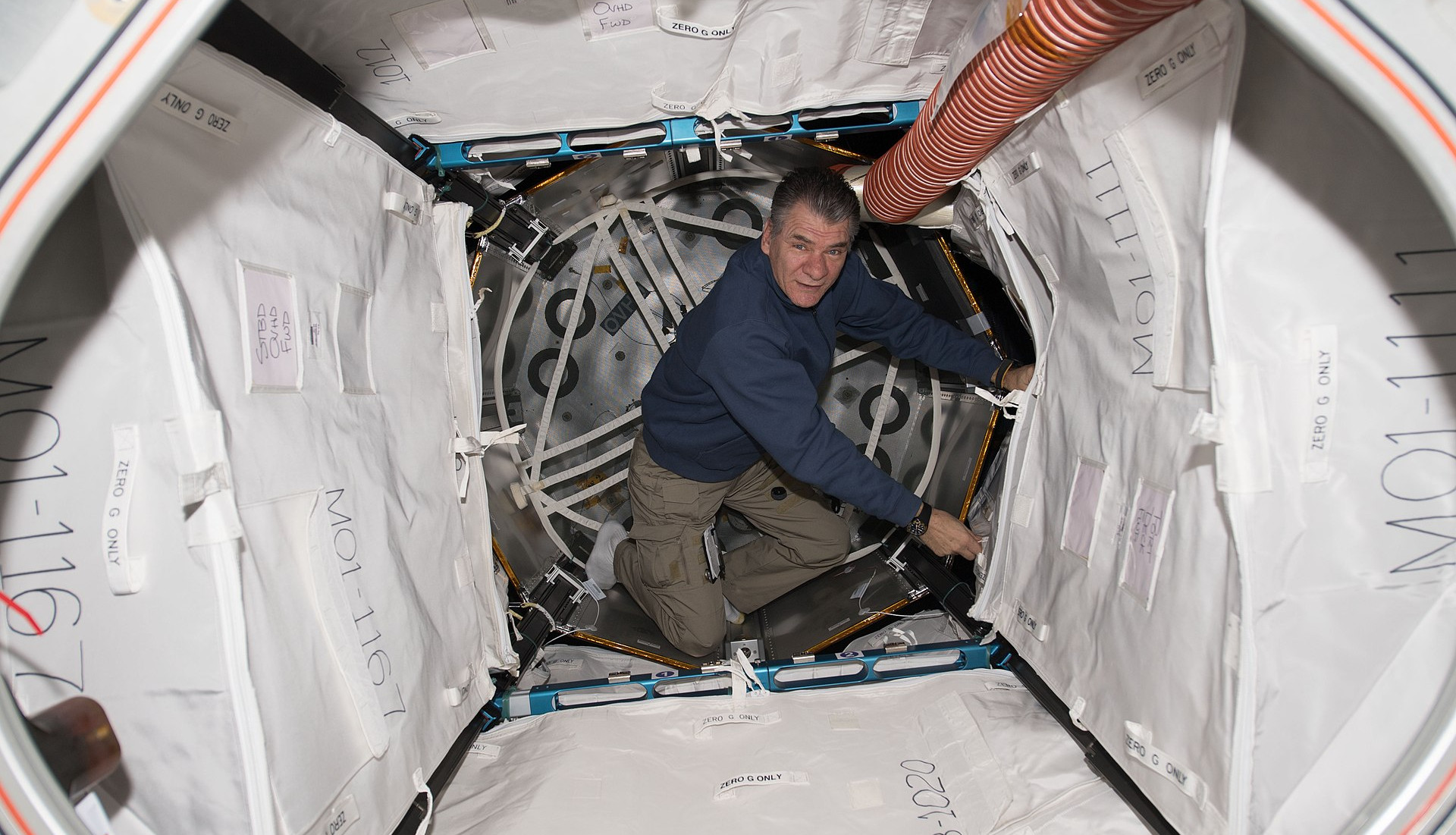
Unfortunately, Bigelow Aerospace laid off all of its employees in March 2020, and the company suspended operations entirely in 2021. While no official announcement was ever made, the company is now considered defunct.
SIERRA SPACE
With Bigelow Aerospace out of the running, Sierra Space has emerged as the new industry leader for space-bound expandable structures. Spun off from Sierra Nevada Corporation in 2021, the company is focused primarily on developing not just the Large Integrated Flexible Environment (LIFE) module, but also the Dream Chaser spaceplane. The end goal is vertical integration — with the Dream Chaser bringing crew and cargo to a space station comprised of LIFE modules.
Sierra’s multi-layer inflatable technology includes a Vectran “Restraint Layer”, which the company says makes their modules harder than steel once fully inflated. They’ve also developed a way to place openings, such as for windows or air locks, in the inflatable walls of the module while still exceeding the pressure ratings required for certification by NASA. This capability promises to greatly expand the potential functionality of inflatable modules, which previously had only been designed with openings on either end of the cylindrical structure.
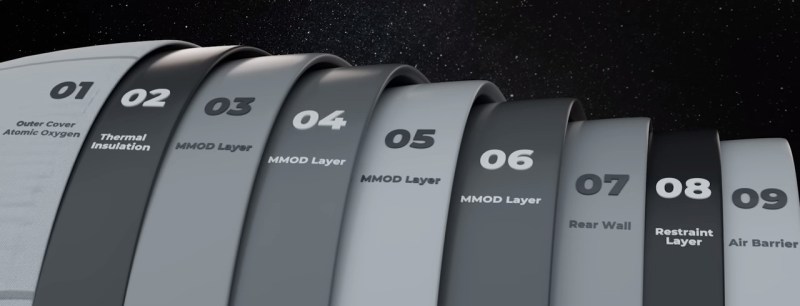
The module that Sierra Space destructively tested recently was a full-scale prototype of what the company calls LIFE 1.0: a structure with an inflated volume of 300 m³ that is 6 m (19.6 ft) long with a diameter of 9 m (29.5 ft), and can be launched in a standard 5 m (16.4 ft) payload fairing. This would make it compatible with rockets such as the SpaceX Falcon 9 and the newly debuted Vulcan from United Launch Alliance.
The next evolution will be LIFE 2.0, which will double the length of the module to 12 m (39.3 ft) to achieve an inflated volume of 600 m³ while retaining the same diameter to stay compatible with current launch vehicles. Sierra Space also has long-term plans for a LIFE 3.0, a massive 1440 m³ module that would have more usable volume than the entire International Space Station. With a length of 16.2 m (53 ft), an inflated diameter of 11 m (36 ft), and a packed diameter of 7 m (23 ft), putting LIFE 3.0 into orbit would require a next-generation launch vehicle such as NASA’s SLS Block 1B Cargo, the SpaceX Starship, or the New Glen from Blue Origin.
NEXT STEPS
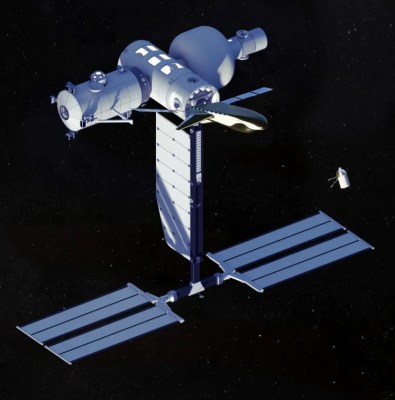
According to the press release from Sierra Space, 2024 will be a busy year. There will be several more tests, with both full-size and sub-scale articles, and they’ll also be working on the Micrometeoroid Orbital Debris (MMOD) layers which will be critical to protect the module from the inevitable impacts that will come with long-duration spaceflight.
As for the first practical application of the technology, Sierra Space and Blue Origin are working together to develop the Orbital Reef commercial space station, which is slated to have at least one LIFE module as part of its baseline configuration. NASA awarded the Orbital Reef project $130 million in December of 2021, with the goal of having it operational by the time the International Space Station is retired, which is currently scheduled for sometime in 2030.
While it looks like it won’t end up happening on the ISS, with a bit of luck, NASA’s dream of having astronauts living and working in an inflatable space station may finally become a reality before the end of the decade.
Posted in Featured, Original Art, Space
No comments:
Post a Comment